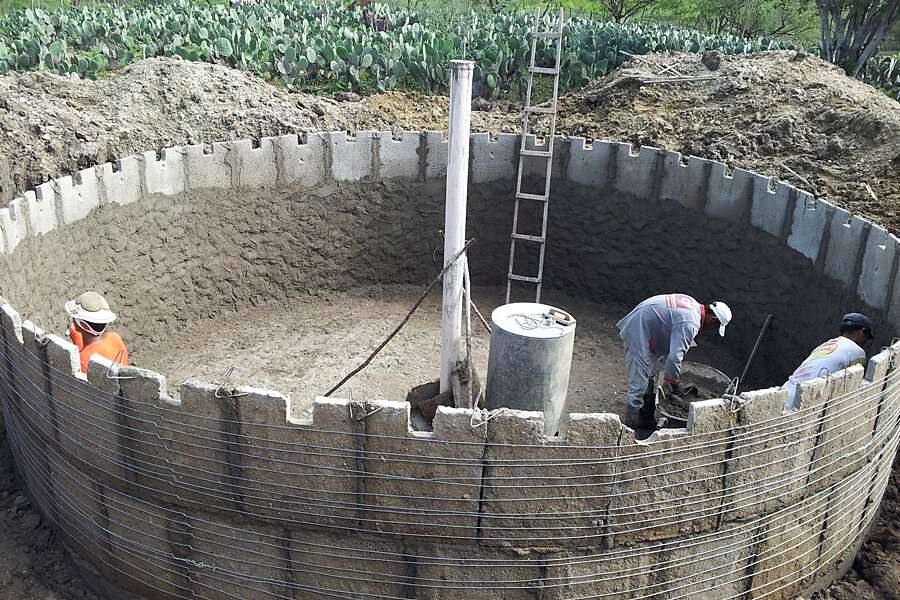Brazil's long-impoverished northeast rides into the middle class
| Cumaru, Brazil
Surviving as a farmer in the semi-arid northeast of Brazil has never been easy – drought is perennial, poverty is highly concentrated, and for decades the region was known best known for its migratory patterns toward cities and the wealthier south. But Maria Joelma da Silva, standing on a dusty path that cuts through her cactus-covered backyard, emphasizes that farming here is “viable” – and her experience proves it.
Six years after The Christian Science Monitor first met Ms. da Silva, she's proving that Brazil's recent economic growth and social programs not only boosted her individual quality of life, but that of the region as a whole.
Back in 2008, The Christian Science Monitor’s Sara Miller Llana wrote a series on Brazil’s economic rise. One article introduced readers to da Silva, a young mother in the northeast using a combination of government subsidies and NGO support to build a cistern on her family’s property. The water storage system improved the farm’s productivity, and allowed her to start a small business selling produce and honey.
At the time, da Silva, her husband, and their three sons were riding the wave of economic growth that bolstered policies aimed at bringing Brazil’s poor into the middle class. They were benefiting from Bolsa Familia, a program that gives small cash payments for sending kids to school and getting them vaccinated, and for the first time had access to cheap credit and government loans.
Da Silva’s cistern added an element of stability on her farm, which could go years without substantial rainfall. At the time, she explained her motivation to find a way to thrive in the drought-prone region:
We want to show “people that it is possible to stay here and live a dignified life," says da Silva, who, a few years back, during a particularly harsh drought, had to sell her only cow for food for her three children. Now she has three cows, grows lemons and oranges, and has purchased two hectares of land to expand down the hillside from her home – five times what she previously owned.
'Not just about me'
Six years after the Monitor last spoke with da Silva, some of her hopes for the region are coming true. The northeast is still the poorest area of Brazil, but it’s now also the fastest growing, with large-scale industrial projects like the Suape port complex near Recife and the construction of one of state-owned oil company Petrobras's largest refineries offering employment opportunities and an injection of much-needed capital.
Between 2002 and 2012, the middle class in the northeast grew from 22 percent of the population to 42 percent. Nationally, the middle class went from 30 percent of the population to 52 percent during the same period. Social programs like Bolsa Família and an increase in the minimum wage (about 60 percent between 2003 and 2011) have helped bring about change here. And for farmers, ways to conserve water for family consumption as well as for agriculture and livestock during dry spells has been vital: An estimated 600,000 cisterns have been built in the region as of 2012, according to Asa Brazil, an NGO that works to bring cisterns to rural, poor communities.
There is plenty of development work yet to be done. The road to da Silva’s home is still a 20-minute drive from the nearest paved road. The bumpy ride to her doorstep passes by a landfill that reaches as far as the wind can blow the plastic bags and decomposing papers dumped there. But since 2008 her property has almost tripled in size, going from about six acres to just over 17 acres today. Her land is divided, with the cows, honeybees, and crops including tomatoes, carrots, onions, and lettuce, spread out on their own plots of land.
On a recent afternoon, da Silva’s property is buzzing with activity: four men splatter and smooth wet concrete on the curving internal walls of a large cistern. It’s the fourth – and biggest – to be built on her property, and she says the water storage systems are crucial to her staying power. Her farm’s success is considered a model by area NGOs, and since 2008 she’s been flown to Argentina and Ecuador to share her experience with farmers living in similarly harsh climates.
Da Silva stopped taking Bolsa Familia payments in 2010, as her family became more economically stable. The most recent development on her farm is the start of biogas production, combining cow dung and water and letting it decompose to provide the family with free cooking fuel. Five months ago, a Swiss organization selected her to pilot the project here because of her past success.
“What makes me truly happy is that it isn’t just us that’s doing well,” da Silva says, a baseball cap shielding her eyes from the pounding sun. “Families in the region as a whole are doing better.”
She says she’d like to produce and sell more at the nearby markets, and she’d also like to buy a new car to transport her produce more efficiently.
“We are always searching for the best. It’s not just about me being in a good situation, it’s about me and others” living in the northeast doing better, she says. “When together we can stay on our land and show the country that we can do that successfully? It makes life all the better.”
Whitney Eulich reported from Brazil as a fellow with the International Reporting Project (IRP).








